
Philippines
Sampaguita
Jasminum sambac

General Description/Cultural Significance
The Philippines is composed of over 7,000 distinct islands in the Pacific Ocean where 120 different languages and dialects are spoken. One of the factors that unites these places is the familiar scent of the Sampaguita flower and the folktale that it represents. In a Filipino legend, Lakambini, a woman, was the only heir to a barangay and faced threats of invasion from other islands. Her lover, Lakan Galing, led the men of the barangay to fight the potential invaders and when they said goodbye to one another they repeated the words “Sumpa Kita,” (I promise you) hoping to ensure that they would be together again soon. Lakambini waited for Lakan Galing on a flower-covered hill and died there in grief when she realized Lakan Galing would never return from the battle. Sweet smelling white flowers grew over Lakambini’s grave which were thereafter named Sampaguita flowers after the “Sumpa kita” pledge the lovers made to one another. The Sampaguita flower remains culturally significant beyond this legend and is used to make garlands, leis, and corsages as gifts for guests and dignitaries. They can also be found in religious altars and Filipino recipes, references in songs and dances, and even ice cream flavors.
Climate Change/Conservation Status
According to the Global Climate Index of 2015, The Philippines is the single most vulnerable country to climate change in the world. It is a country which contributes less than 0.4% to the world’s climate crisis but faces some of the harshest consequences from the pollution of the global north, which is responsible for 92% of climate change impacts. The numerous islands within the Philippines are subject to extreme weather conditions worsened by climate change including five of the ten most devastating typhoons in the country’s history since 2006. Mangrove forests are the islands’ natural defense against rising sea levels and storms, but unfortunately these forests are shrinking. The impacts of these changes are felt throughout Filipino society but most especially by vulnerable impoverished groups. According to the International Panel on Climate Change these impacts will increase the number of Filipinos living below the poverty line while simultaneously decreasing the projected maximum fish catch potential by as much as 50% by the year 2060. The Sampaguita flower is named for its connection to promises and everlasting love. It is this devotion that is going to be needed to the reorient international community to protect vulnerable nations such as the Philippines from the devastation of climate change.
Sources
Murga, A., 2022. Filipinos Count Cost of Climate Crisis as Typhoons Get Ever More Destructive.
[online] the Guardian.
National Integrated Climate Change Database and Information Exchange System. 2022.
Climate Change Impacts.
World Bank. 2022. Getting a Grip on Climate Change in the Philippines. [online]

